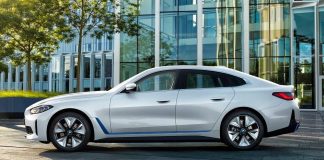If you don’t build it first, at least build it better — then it won’t matter as much whose idea it was to begin with.
So while Chrysler gets credit for conceptualizing the retro-runabout PT Cruiser — a versatile and inexpensive car-based, compact wagon with old school 1940s styling touches and the look of a custom-built hot rod — Chevy’s HHR copycat does a better job of executing the concept.
Like the Dodge Neon-based PT Cruiser, the HHR (Heritage High Roof) is built on a modified small car chassis; in this case, the donor platform is GM’s “Delta” architecture and the bits and pieces are shared with the Chevy Cobalt. But unlike the getting-long-in-the-tooth Neon, the Cobalt’s chassis reflects the very latest and best small car technology — including features like a completely transparent electric-assist power steering system that’s both precise and energy efficient (less wasted mechanical energy to drive a power steering pump means better fuel economy).
Because the HHR gets the benefit of being based on a newer, more up-to-date car chassis, it not surprisingly feels newer and more up-to-date when you drive it than the getting crickety PT Cruiser — which was launched back in 2000.
It’s also a more substantial-looking vehicle — being 7 inches longer, two inches wider and two inches taller than the PT Cruiser — even if the total cargo capacity of both vehicles is roughly the same inside. (The PT actually has slightly more total cargo area with its second row seats folded — 63 cubic feet vs. the HHR’s 56 cubic feet. But the HHR’s got a bit more luggage space — 23 cubic feet vs. the PT’s 21.6 cubic feet.)
Another area where the HHR’s newness shines bright is under the hood. There’s the already mentioned electric assist-steering — but especially noteworthy is the HHR’s standard 2.2 liter engine (also shared with Cobalt). Though it’s not as large as the PT’s standard 2.4 liter engine, the power output of both engines is pretty much a dead heat — 149 for the HHR, 150 for the PT. But the HHR’s smaller, more efficient engine delivers significantly better economy — in particular, the automatic-equipped model. The PT with automatic transmission is a near gas-pig (for a vehicle of this type), with an EPA rating of 20 MPG city/25 highway — while the HHR with the automatic transmission kicks it up a notch to 23 city/30 highway.
With unleaded regular now running close to $3 (or more) per gallon, that extra 5 mpg on the highway is money in your pocket.
The icing on the cake? The more fuel-efficient HHR doesn’t suck when you floor it — at least, not relative to the PT. Both retro-runners achieve 60 mph in just over 10 seconds — not zippy, but certainly acceptable. Especially if you’re knocking down 30 mpg on the highway. I cruised to Richmond, Virginia in my tester from the home base in Roanoke — about a 200 mile trip — and the HHR was comfortable hanging in the left lane at 80-90 something following discretely behind a Lexus “blocker car” that I politely let lead and set the pace.
The downside for leadfoots who want more go with their show is that the hotrod-looking HHR is only being offered (for now) with one mild performance upgrade — a 172-hp 2.4 liter engine that’s frankly not even in the same league as the Neon SRT-4 sourced, turbocharged high-performance engine you can get in the PT. But it’s a sure bet if the HHR does well in the market, Chevy will have something a bit more competitive in the bin for 2007 or 2008. The rumor mill has it that the supercharged engine used in the Cobalt SS will be offered as an option next year as part of a high-performance HHR.
But the bottom line cost of the copycat Chevy really cinches the deal.
If you go by MSRPs, it’s true you’ll pay about $1,300 more for the HHR (base price of the Chevy is $15,800 vs. $14,485 ) but for that money you will get features either not offered in the base PT at all or which you’d have to pay extra for — like a power rear liftgate and remote engine start feature. Unbelievably, air conditioning isn’t included in the base price of the PT. This virtual necessity adds an additional $1,000 to the price of the Chrysler; ABS adds another $595. In the HHR, however, AC is standard — vitiating the PT’s illusory price advantage. The HHR also comes standard with 16-inch rims (the PT has 15s) and can be ordered with curtain airbags (not available in the PT).
Unlike the stripped-down base model PT, the standard LS model is very appealing in its own right and completely serviceable. But for a higher-line experience there’s the top-of-the-line HHR LT, which comes with the larger 2.4 liter engine (172-hp), 17-inch styled road wheels, an FE3 sport suspension package, bright chrome trim on the inside and a premium audio system with CD-changer and MP3 capability. The HHR LT stickers at $16,820 — which is only about $230 more than you’d pay for a base model PT with extras like AC, ABS and side airbags.
That’s hard to knock — even if the HHR wasn’t first on the block.
Throw it in the Woods?









